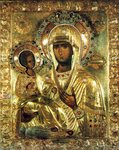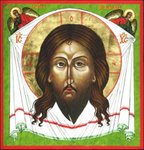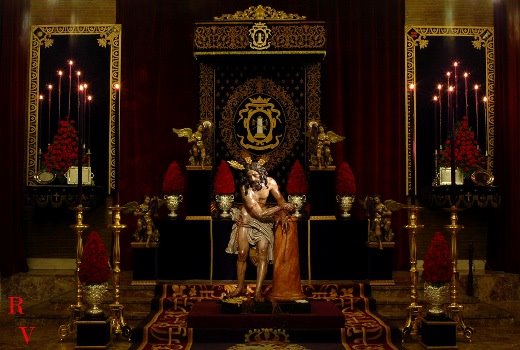All Hallows' Eve

I felt a chill wind blowing through my legs today. I was sitting on a bench in school, waiting for my brother to finish rescheduling an appointment with the Guidance Office; since classes had all but ended already, I found myself alone, under a (thankfully) bright and sunny day with nothing but my iPod to intrude upon the blessed silence of it all. Jarring, though, was the wind; it reminded me of stories the pious old women of our family would narrate, seemingly always at this point of the year.
I remember Tia Luisa, my grandmother's cousin, visiting us some years ago. She was a kind, frail old woman, a member of a powerful charismatic Catholic sect; she had once worked as a teacher, but old age had gotten the better of her. To augment her meager pension, she would sell shoes to people in her neighborhood. She happened to know a shoemaker from her charismatic group, who made quality shoes and who was willing to give her a commission at her strong insistence. I've always admired her; it takes a lot of guts for anyone to hop into a moving jeepney at 11 in the evening, much less for an 80 year old woman nearly bent from old age. Anyway, it was on a stormy October night in 2002 or 2003 that saw her visit us. I remember she was dressed in an immaculate white blouse and a purple skirt that almost reached the ankles. All she needed was a Sacred Heart scapular and a long white veil, and she would look like your typical Filipina church lady.
My grandmother served Tia Luisa tea and some hot soup. One thing I notice with Filipinos of an older generation is their insistence on deference and politesse; my grandmother addressed her with the characteristic 'po' and 'opo' with which many children here still address their parents. To think they were separated by probably ten years at most. Tia Luisa had brought with her some beige pumps, a pair of loafers, and some sheets of paper to trace an interested party's foot on, in case he wanted his own pair of shoes. Thunder raged outside. Tia Luisa then motioned for my grandmother to come closer and proceeded to narrate a rather strange tale.
'I saw my father a few days ago', she said. 'It was him all right; he had the same piercing eyes which he always focused on me so intently whenever he looked at me. But at the same time, he wasn't really looking, or if he was, he probably wasn't aware that I could see him. I was scared, all right, and I started to pray the holy rosary haltingly, since I was so scared.' My grandmother listened to her story intently, but with some incredulity. I have mentioned before that that side of my family is no longer Catholic; but, I think, having been raised in the very much Catolico cerrado milieu of the early twentieth century, when all the Evangelical sects and the Iglesia ni Criso were not even a pipe dream in history, my grandmother retained a large part of that ethos. Thus, it would not have been that hard for her to be convinced of the story. Tia Luisa continued, 'When I finally snapped out of that trance, I immediately hurried to my room, where I had a blessed candle stashed in my altar. I lit the candle and started to pray for the repose of my father's soul. The wind howled all the more and lightning and thunder crashed outside my window. I was so scared. To think I already had palaspas (blessed palms) tied on my windows!'
'After some minutes, the rain and the storm and the thunder subsided. But I was still afraid to go near the window. Our elders always told us that on the days before All Souls' Day, the souls in Purgatory are permitted to roam about the earth to remind the faithful to pray for them. So that's what I did; I had Mass said for his repose in seven churches, but I remained inside the house for the rest of the month. I was especially fearful to go out at night.'
Tia Luisa ended her story by taking a swig at her hot tea. All that time, I sat nearby, listening to every detail of her story. I, too, was shaken. My grandmother asked her if she wanted some more tea and soup, but she declined. The rest of the details are now fuzzy, but I recall my grandmother saying something like, 'There is too much in this world that we really do not know about. We should all pray for God's guidance.' At around 9pm, and exhausted from the day's activities, Tia Luisa retired to her bed. My grandmother told us all to be very quiet; it would be very disrespectful of us children to cause a ruckus at night and disturb an elder's sleep. And besides, we were all quite tired ourselves.
A few days later was All Souls' Day. We left for Sucat in the early afternoon, and arrived at the Manila Memorial Park at around three-- the Hour of Mercy, I thought. There were candles, bibles, and rosaries a plenty, but mostly confined to the Catholic side of the family. As usual, I spent a good amount of time roaming the cemetery, soaking in all its somber beauty, the silences of which were seemingly ready to burst with screams of anguish and lamentation. At 5pm, we gathered at my grandfather's puntod, the last golden-red rays of the sun stabbing through thick foliage and casting an eerie glow about the place. And for the first time in my life, I saw my Protestant grandmother pray the holy rosary.






















